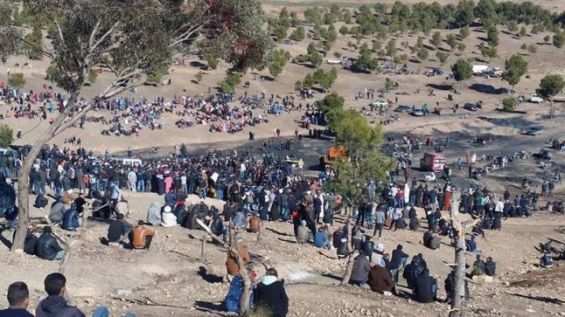While thousands of protesters took their anger to the streets in the city of Jerada denouncing unemployment and poverty, the Ministry of Energy, Mining and Sustainable Development revealed the amount of money spent on the north-eastern province from 2003 to 2017. Answering a question at the House of Counsellors (upper house of the Parliament), Aziz Rabbah, head of the ministry, explained that investments in Jerada amounted to 12.3 billion dirhams in the last 14 years.
12 billions in 14 years
As reported by MAP news agency, with details related to what the government and most particularly the ministry in charge, spent on the province, Rabbah indicated that «these investments included infrastructure with 224 projects planned, for an overall budget of about 1.543 billion dirhams, and productive sectors, with 28 projects, for around 10 billion dirhams, particularly in the energy sector». This sum was also covering the social aspects, deemed affected negatively after the end of the exploitation of the mines in the city, through the implementation of 111 projects for a budget of 380 million dirhams, in addition to 336 projects under the National Initiative for Human Development (INDH) for 340 million dirhams.
Commenting on the event that changed Jerada’s future, the Minister pointed out that «the State had to close Jerada’s mine, which was one of the largest in the Kingdom and a collective agreement was signed in this regard in 1998». According to him the total compensation related to the closure of this mine amounted to 2.2 billion dirhams, adding that «4,647 employees received compensations worth 1.3 billion dirhams».
Benhima's figures
The figures given by Aziz Rabbah, former Minister of Equipment, Transport and Logistics since January 2012 who was appointed by King Mohammed VI as Minister of Energy, Mines and Sustainable Development on April the 5th 2017 were backed by others given by Driss Benhima, former Chairman of the National Office of Electricity, a client of CdM, and former Minister of Transport, Energy, Tourism, Mining and Merchant Navy. Speaking to Medias 24 about the closure of Charbonnage du Maroc, Benhima who was also heading the mine’s restructuration plan set by the liquidation commission of CdM, explained that in March 1998 they «signed a memorandum of understanding with the trade unions for the gradual departure of employees and then closed it definitively three years later».
With his own figures, the official, who had also been heading Royal Air Maroc in the past, indicated that the government has allocated at the time the most generous social plan in the history of Morocco to the staff of the mine : 3 billion dirhams for 5,000 employees which would translate to 600,000 dirhams per person.
To put it in others words, Benhima announced to Media 24 that «1.3 billion dirhams were allocated to compensate the 5,000 employees, an average compensation of 260,000 dirhams».
«We also paid 1.7 billion dirhams to the social security funds so that the workers could benefit from reimbursement of medical care and their retirement pensions».
«Apart from the 3 billion dirhams, we must also consider the social housing offer that was set at the time». According to Benhima, CdM’s employees were sold social housing at a very low price, around 90% lower than the then-market value estimated by a prefectural commission which was very conservative in its evaluations (the sale price was established at about 10,000 dirhams for each housing unit), he added.
The compensation varied
While Rabbah and Benhima spoke about a social plan that helped the employees benefit from at least 270.000 to 300.000 dirhams each, miners in the city of Jerada gave another version to the story. In fact not all miners mentioned by the two officials were compensated equally. This account was confirmed by Mustapha Selouani, a UMT trade unionist based in Jerada.
Contacted by Yabiladi, he insisted that indeed when CdM closed its doors in 1998, employees were compensated on the basis of their status and former ranks. «The firm had its own standards which it took into consideration, I must say, such as seniority, rank and position», said Selouani adding : «A mere miner was not given what the clerk or the engineer were granted».
«The compensations ranged from 60.000, 80.000 and sometimes up to 120.000 dirhams, while others managed to get up to 1.200.000 dirhams».
On the other hand, Rachid Essaltani, a resident of Jerada, whose father worked with Charbonnage du Maroc and died years later suffering from anthracosis, gave a similar explanation to other interviewees who lived in the city. «Compensation received by CdM’s employees varied from one worker to the other and it all depended on the social plan set at the time after the closure of the mine», he told Yabiladi. For the young man, an average estimation would be close to 200.000 dirhams each.
Speaking of investments, Selouani argued saying : «The government is talking about 12 billion dirhams, we actually don’t know how this money was managed». He argued that only «two squares were constructed here in Jerada and they destroyed the authenticity of the mineral town. They have just created a space for these unemployed youngsters to hang out in».
Income-generating projects
«I am talking here about the income-generating projects. If they think that refurbishing a pavement or building a square is going to create jobs, they are wrong».
Beside the fact that these compensation plans couldn’t cover the needs of a city like Jerada, the laid off miners were left in a weak state struggling to be compensated on the basis of their severe health issues. Speaking to Essaltani who is also member of a local collective of coal workers and their sons, he explained that miners who managed to prove that «they were severely affected by anthracosis (the asymptomatic, milder type of pneumoconiosis as caused by the accumulation of carbon in the lungs due to repeated exposure to air pollution or inhalation of smoke or coal dust particles), can be compensated on that basis too». However the procedure is quite slow, according to the Jerada native. Infact, workers should see an approved medical practitioner to determine how each minor is affected by Anthracosis. On the basis of this diagnosis, these workers send their files to the court which sets the amount of money they are meant to receive.
Moreover, he added that if these coal-miners do not file lawsuits demanding their right to be compensated for the health issues they are suffering from, they will be deprived from these compensations. It is known as the statute of limitations, a law which sets out the maximum time that parties have to initiate legal proceedings from the date of an alleged offense and in this case the period is limited to 15 years.
Meanwhile, Selouani indicated that the problem was bigger than that. Even when they received decent compensations, these miners did not make sensible choices with their money. «Some were compensated and 15 days later they were left with nothing to live with, others bought houses and invested with the rest but their businesses shortly collapsed and they ended being broke», added the trade unionist.
Despite the compensation sums allocated to coal-miners, the city needed more than that. Voicing their demands for twelve days now, the inhabitants of Jerada are in need of social and economic projects that would bring their city to life. And although, the numbers announced by the Ministry of Mines are huge, little has been done to secure a living for the mineral town’s miners.





 chargement...
chargement...













